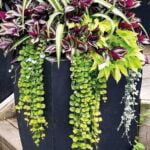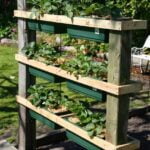Are you looking for landscape vines ideas to enhance the beauty of your outdoor space? Incorporating vines into your landscape design can bring numerous benefits, from adding visual interest to providing functional benefits like shade and privacy. In this article, we will explore the many ways you can use vines to create a stunning and unique landscape design that is both beautiful and practical.
When it comes to incorporating vines into your landscape design, there are endless possibilities. From creating living walls to using vines as ground cover or trellising them for a creative effect, there are numerous ways to add a touch of natural beauty to your outdoor space. Not only do vines add aesthetic appeal, but they also offer practical benefits such as cooling shade and edible fruits.
Choosing the right vines for your specific climate and soil type is crucial in order to ensure their successful growth and longevity. Whether you are looking for low-maintenance ground cover options or want to create a breathtaking vertical garden, selecting the appropriate vine species is essential. In the following sections, we will explore different types of vines that thrive in various conditions, along with maintenance tips and real-life examples of stunning landscape designs featuring vines.
Choosing the Right Vines for Your Climate and Soil Type
When choosing the right vines for your climate and soil type, it is important to consider the specific conditions of your area in order to ensure that the vines will thrive in your landscape. Different varieties of vines have different requirements when it comes to climate and soil, so it is essential to do your research before making a selection.
For example, in warmer climates, you may want to consider heat-tolerant vines such as bougainvillea or trumpet vine, while in cooler climates, hardy options like clematis or wisteria might be more suitable. Similarly, some vines are more adaptable to different soil types, with some preferring well-drained soil and others thriving in more moist conditions.
It is also worth noting that certain regions have specific regulations regarding certain types of vines due to their invasive nature. For instance, English Ivy is considered an invasive species in parts of North America and should be avoided in these areas. Be sure to check with local gardening associations or extension services for guidance on which vines are suitable for your region.
Finally, it can be helpful to consult with a professional landscaper or horticulturist when choosing the right vines for your landscape. They can provide expert advice based on the specific conditions of your outdoor space and help you select the most suitable varieties for your needs.
| Climate | Recommended Vines |
|---|---|
| Warm Climate | Bougainvillea, Trumpet Vine |
| Cooler Climate | Clematis, Wisteria |
Vertical Gardening With Vines
When it comes to creating a stunning and unique landscape design, incorporating vertical gardening with vines can be an excellent choice. Whether you have a small backyard or a large outdoor space, utilizing vines to create a living wall can add depth, texture, and beauty to your landscape. One of the key benefits of vertical gardening with vines is the ability to maximize space while also increasing visual interest.
Choosing the right vines for your living wall will depend on your climate and soil type. It’s important to select vines that are well-suited for your specific region in order to ensure their success and longevity.
For example, if you live in a warmer climate, you may want to consider heat-tolerant vines such as bougainvillea or trumpet vine. On the other hand, if you reside in a cooler climate, cold-hardy varieties like clematis or climbing hydrangea may be more suitable.
When it comes to creating a stunning living wall with vines, there are endless possibilities for creativity and design. Whether you prefer a lush and dense look or something more minimalist and structured, the art of trellising offers various ways to support your vines.
From simple lattice structures to elaborate metal frameworks, there are countless options to showcase your vertical garden in a visually striking way. With careful planning and attention to detail, vertical gardening with vines can truly transform any outdoor space into a captivating oasis.
Vines as Ground Cover
Vines are a fantastic way to cover the ground in your landscape while adding beauty and minimal maintenance. By using vines as ground cover, you can reduce the need for mowing, weeding, and watering in those areas. Here are some benefits of incorporating ground cover vines into your landscape:
- Reduced maintenance: Ground cover vines help in reducing the time and effort required for maintaining your landscape. They work as a natural weed suppressant, reducing the need for constant weeding.
- Erosion control: Vines with a spreading habit help in stabilizing soil on slopes and preventing erosion. This is particularly useful in areas where heavy rain or wind can cause soil erosion.
- Aesthetic appeal: Ground cover vines add a beautiful touch to your landscape, creating a lush and green carpet-like effect. They also provide a pop of color when they bloom, enhancing the visual appeal of your outdoor space.
When choosing vines for ground cover, it’s important to consider your climate and soil type to ensure their success. Some popular options for ground cover vines include creeping fig (Ficus pumila), wintercreeper (Euonymus fortunei), and periwinkle (Vinca minor), among others. With proper selection and care, these vines can transform a bland area of your landscape into a visually stunning feature that requires minimal upkeep.
In addition to their low maintenance nature and beauty, ground cover vines also play an important role in providing habitat for beneficial insects and wildlife in your yard. Whether you have a small garden or an expansive outdoor space, these versatile plants offer an array of benefits while enhancing the overall aesthetics of your landscape.
The Art of Trellising
Vines are a beautiful and versatile addition to any landscape design. When it comes to trellising, there are countless creative ways to support your vines and create an eye-catching feature in your outdoor space. Whether you’re looking to add visual interest to a garden, cover a plain wall, or create a living privacy screen, trellising your vines opens up a world of design possibilities.
One popular method of trellising is using an arbor or pergola. These structures not only provide support for climbing vines but also add an architectural element to your landscape. Planting vines at the base of an arbor and allowing them to climb up and over the top creates a stunning focal point in any garden. Additionally, creating a natural canopy for shade and relaxation.
Another creative way to support your vines is through the use of wire or mesh frames. This method allows you to train the vines into specific patterns, shapes, or even words if desired. Wire or mesh frames can be attached directly onto walls, fences, or freestanding supports, adding a unique and personalized touch to your landscape.
When designing with trellises, consider incorporating recycled materials such as old window frames, ladders, or driftwood. Not only does this add character and charm to your outdoor space, but it also showcases your commitment to sustainability in gardening practices.
| Trellis Material | Design Example |
|---|---|
| Recycled Wood | A rustic wooden ladder repurposed as a vertical garden trellis. |
| Metal Frame | An ornate metal frame used as a backdrop for climbing roses. |
| Bamboo Poles | An Asian-inspired garden featuring bamboo poles arranged in a grid pattern for vine support. |
Vines for Shade
When it comes to creating a cool and inviting outdoor space, incorporating vines into your landscape design can significantly enhance the overall ambiance. Vines are not only aesthetically pleasing but also serve as natural shade providers.
As they climb and spread, they create a natural canopy that helps reduce the temperature and block out the sun’s harsh rays. This not only adds a cooling effect to your outdoor living area but also makes it a more comfortable place to relax and entertain.
Here are some ideas for incorporating shade-providing vines into your outdoor space:
- Planting fast-growing vines such as wisteria or trumpet vine that can quickly cover pergolas, arbors, or trellises to provide instant shade.
- Utilizing climbing roses or clematis on an existing structure like a fence or wall to create a beautiful and shady backdrop.
- Installing a living umbrella by training vines over an arched structure or overhead wires to create a natural canopy of greenery.
In addition to providing shade, these vine-covered structures also add visual interest and beauty to your landscape. With careful selection and placement, you can transform any outdoor area into a tranquil oasis that is both functional and visually stunning. By choosing the right vines for shade and strategically placing them in your outdoor space, you can enjoy a cooler environment while enhancing the overall appeal of your landscape design.
Incorporating Edible Vines Into Your Landscape
When considering which edible vines to incorporate into your landscape, it’s important to take into account your climate and soil type. Certain varieties of edible vines thrive in specific conditions, so it’s essential to choose the right plants that will flourish in your area. For example, grapevines are well-suited for Mediterranean climates, while kiwi vines prefer cooler temperatures. Researching the best edible vine options for your particular location will ensure successful growth and a bountiful harvest.
In addition to their practical benefits, such as providing fresh fruit for consumption, edible vines can also add visual interest to your landscape. Imagine walking through your yard and being greeted by vibrant clusters of grapes hanging from an arbor or trellis.
Not only does this create a picturesque scene, but it also allows you to effortlessly pluck ripe fruit for snacking or cooking. By integrating edible vines into your landscape design, you can elevate the aesthetic appeal of your outdoor space while reaping the rewards of homegrown produce.
Maintenance Tips for Keeping Your Landscape Vines Healthy and Thriving
Regular Pruning and Trimming
One of the most important maintenance tasks for keeping your landscape vines healthy and thriving is regular pruning and trimming. This not only helps to control the growth of the vines, but it also promotes air circulation and sunlight exposure, which are essential for the overall health of the plants. It’s important to remove any dead or damaged parts of the vines, as well as to shape them according to your design preferences.
Proper Watering Techniques
Another crucial aspect of maintaining healthy landscape vines is ensuring that they receive proper watering. The water needs of vines can vary depending on factors such as the climate, soil type, and the specific needs of the plant species. It’s important to water deeply but infrequently, allowing the soil to dry out between watering sessions to prevent waterlogged conditions that can lead to root rot.
Pest and Disease Management
In order to keep your landscape vines healthy and thriving, it’s essential to stay vigilant against pests and diseases that can affect these plants. Regular inspection of the vines for signs of pest infestations or disease symptoms is crucial. In cases where issues are identified, prompt action must be taken using appropriate organic or chemical remedies if necessary in order to protect the health and vitality of your landscape vines.
By following these maintenance tips for keeping your landscape vines healthy and thriving, you will ensure that these beautiful plants continue to enhance your outdoor space for years to come. Prioritizing regular pruning and trimming, proper watering techniques, and proactive pest and disease management will contribute significantly towards their long-term health and beauty.
Overcoming Common Challenges When Growing Vines in Your Landscape
Understanding Common Challenges
Growing vines in your landscape can be a beautiful and rewarding experience, but it also comes with its fair share of challenges. One common issue that many gardeners face is the aggressive growth of some vine species. While fast-growing vines can provide quick coverage, they may also become invasive and difficult to control. Another challenge is finding the right balance of sunlight and shade for your vines, as some species may struggle to thrive in certain lighting conditions.
Choosing the Right Vines
To overcome these challenges, it’s important to carefully choose the right vine species for your landscape. Look for native or non-invasive varieties that are well-suited to your climate and soil type. Consider factors such as the vine’s growth habit, preferred light exposure, and water requirements. By selecting the right vines from the start, you can minimize potential issues and create a thriving landscape that enhances the natural beauty of your outdoor space.
Maintaining Healthy Growth
Once you’ve selected the appropriate vines for your landscape, it’s essential to establish a regular maintenance routine to support healthy growth. Pruning is a key aspect of vine care, as it helps control growth, shape the plant, and promote better flowering or fruit production.
Additionally, providing proper support structures such as trellises or arbors can prevent damage to nearby structures or trees. By staying proactive with maintenance tasks, you can ensure that your landscape vines continue to enhance the aesthetic appeal of your outdoor environment while avoiding common challenges.
Showcasing Real-Life Examples
In conclusion, incorporating vines into your landscape design can bring a myriad of benefits to your outdoor space. From adding beauty and coolness with shade-providing vines to creating stunning living walls with vertical gardening, the possibilities are endless. By choosing the right vines for your climate and soil type, you can ensure that your landscape will thrive and remain low maintenance, all while adding a touch of natural beauty.
When it comes to trellising, there are countless creative ways to support your vines, whether it’s using traditional wooden or metal structures or allowing them to climb up existing features in your outdoor space. Additionally, incorporating edible vines into your landscape not only adds beauty but functionality as well, providing a fresh source of produce for your kitchen.
To keep your landscape vines healthy and thriving, be sure to follow some maintenance tips such as regular pruning, proper watering, and addressing any pest or disease issues promptly. While there may be some common challenges when growing vines in your landscape, with the right knowledge and preparation these obstacles can easily be overcome.
And finally, by showcasing real-life examples of inspiring landscape designs featuring vines, you can gather plenty of ideas for how to incorporate these beautiful plants into your own outdoor space. With these landscape vine ideas in mind, you’ll be well on your way to creating a stunning outdoor oasis that is both visually appealing and functional.
Frequently Asked Questions
What Vine Spreads Quickly?
The kudzu vine is known for its rapid growth and ability to spread quickly. Native to East Asia, it has gained a reputation as an invasive species in many parts of the world due to its quick and aggressive growth.
What Is the Fastest Growing Decorative Vine?
The fastest growing decorative vine is often considered to be the Virginia creeper. This hardy vine is known for its rapid growth rate and its ability to cover walls, fences, and trellises with vibrant green leaves that turn brilliant shades of red and orange in the fall.
What Is the Easiest Perennial Vine to Grow?
When it comes to easy perennial vines, many gardeners recommend the clematis. With their beautiful flowers and relatively low maintenance requirements, clematis vines are popular choices for those looking for a perennial vine that is easy to grow. There are many varieties available, each with its own unique characteristics and growing requirements.

Welcome to my gardening blog! I am passionate about plants and enjoy sharing my knowledge and experiences with others. In this blog, I will write about everything related to gardening, from tips on how to get started to updates on my own garden projects.





